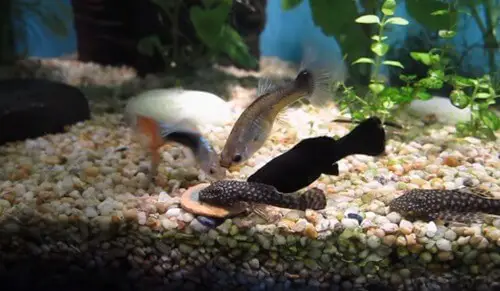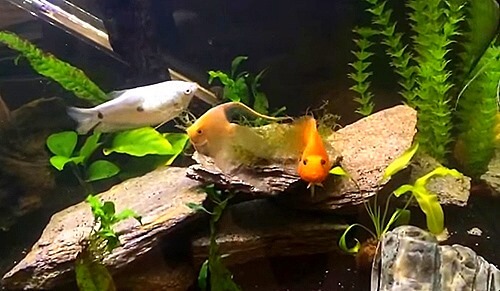Products recommended in this post contain affiliate links. If you buy something through our posts, we may receive a commission at no extra charge to you. See our full disclosures here.
Stocking a freshwater fish tank takes a good deal of thought and preparation in order to ensure that all of the fish in your tank get along. You would not, for example, want to pair a large, carnivorous species of fish with a school of guppies. Neither would you want to overstock your tank with top-dwelling species while leaving the bottom level of your tank empty. Below you will find a number of helpful tips for properly stocking your freshwater aquarium:
Choosing your fish and tank, single-species or community tank?
Once you have set up your freshwater aquarium and installed your equipment it is time to stock the tank. If you have never kept an aquarium before, there are a few things you should avoid.
- First, do not simply go to the pet store and buy the first kind of fish you like – you need to do some research first to see if that type of fish is compatible with your tank.
- Second, you should not buy too many fish at once – if you plan to keep multiple species of fish in your tank there is a right and a wrong way to go about introducing them.
- Ideally, you should do your research and select the kind of fish you want before you purchase and set up your tank. This is the best way to make sure that your tank is customized to suit the type of fish you want to keep.
Peaceful community aquarium

The first thing you must consider before stocking your tank is whether you want to keep just one type of fish or have a community tank. A community tank is simply a tank that accommodates several different species of fish that get along. Community species of fish are typically small or medium in size and they are peaceful in nature – males of the species may get a little territorial at times but, for the most part, they don’t have a problem getting along with other fish.
Semi-aggressive fish tank

A step up from community species are semi-aggressive species of fish. These fish are typically a little larger and they have a higher tendency toward fin-nipping or general aggression. Semi-aggressive fish can be kept in community tanks as long as you only keep one male of each species and as long as you provide plenty of hiding places for your fish in case the semi-aggressive fish starts to bully them.
Aggressive fish tank

Aggressive species of fish are usually the larger, often carnivorous species, which do not get along well with other fish. Some examples of fish that should be kept alone or only with others of their own species include Oscars, male betta fish, several species of cichlid, and certain sharks.
Top, middle, and bottom dwellers
Not only do you need to think about the space available in your tank, but you also have to make efficient use of that space. Freshwater aquarium fish are often bred in captivity, but they were originally taken from the wild so they still retain their natural preferences. In addition to having certain preferences for water parameters, aquarium fish also have preferences for the depth at which they thrive.

Aquarium fish can be divided into three groups based on this preference – top-dwellers, mid-dwellers, and bottom-dwellers. In order to ensure harmony in your community tank you need to ensure that one level of the tank is not overstocked – you need to distribute your fish evenly throughout the tank. When researching fish for your tank, determine their preferences and try to select at least one species for each level of the tank.
Ensure the water parameters ideal for all fish within a tank
In addition to considering how many fish your tank can accommodate, you also need to think about your tank parameters. While you can adjust your tank parameters using chemicals it would be better and safer for your fish to alter the water chemistry in your tank as little as possible.
Before stocking your tank, test your aquarium water to determine its pH and water hardness. These water parameters are difficult to alter with any level of precision, so it is better to choose fish that can thrive within these parameters than to try to change them. It is also important to choose species of fish that have similar requirements for water chemistry.
For example, if you try to keep one species that is used to soft, acidic water in the same tank as a species that prefers hard, alkaline water then one of those species may fail to thrive. The worst case scenario is that one of the species will become stressed by the improper water parameters and die as a result. Do your research ahead of time to make sure that all of the fish you select for your tank will thrive within your tank parameters.
How many fish can your tank stock?

After deciding whether you want to keep a single species of fish or a community tank you need to think about the number of fish that your particular tank can accommodate. You may have heard of the “one inch of fish per gallon” rule which states that any aquarium can hold as many inches of fish as gallons of water. For example, a 20 gallon tank can accommodate 20 inches of fish – this may equate to twenty 1-inch fish, ten 2-inch fish, or any other combination as long as it adds up to twenty.
What you need to realize, however, is that this rule is designed to be used as a guideline – it is not a set-in-stone rule that you should follow to the tee. Use this rule as a starting place by considering the adult size of the fish you intend to keep – the fish may be small when you buy them, but they will certainly grow up. You also need to consider the fact that some fish are wider than others and they may produce more waste. For example, tetras are very thin and flat-bodied while many cichlids have thicker, more compact bodies. In cases like this, the one-inch-per-gallon rule may not work.
Don’t add too many fish at once
When your aquarium has just cycled, the helpful bacteria are only sufficient to handle a certain amount of fish waste. Add too many fish into your tank at the same time can make it overload that is the cause of cloudy water and fish death. So, it is a good idea to buy and add your fish gradually in order not to disturb the balance in your aquarium.
If you plan to keep a community tank you need to be intentional about how and when you add your fish. Though many species of community fish are peaceful in terms of their interaction with other species, they will establish a sort of pecking order within the school. This being the case, you would be wise to add all the members of one species at the same time – any late-comers to the school may be out-competed for food.
If you plan to add any semi-aggressive or aggressive species of fish to your tank, do not start with them. If you add your aggressive fish to the tank first, they may come to view the entire tank as their territory and any fish added later may be regarded as invaders. Start with the most peaceful species of fish and give them time to get used to the tank before you add the next species. This ensures that each species will be able to establish its own territory.
As you should now know, stocking a freshwater aquarium is not a process that should be rushed. You need to think carefully about the size of your tank and its water parameters then select species of fish that will do well in such an environment. Refer to the articles listed at the top of the page to help you select the perfect type and number of fish for your freshwater tank.
Top Editor's Choice on Freshwater Fish Tank
[amazon bestseller="Freshwater Fish Tank" filterby="price" filter="30" filter_compare="more" filter="available" orderby="percentage_saved" order="desc" template="list" items="10" tracking_id="tnk0c-aawp-cro-b-20"]Subscribe to our Newsletter!
Join our mailing list to receive the latest tips and news of our blog.

